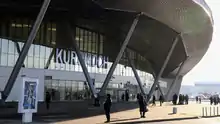Samara
Samara (Russian: Сама́ра, IPA: [sɐˈmarə]), known from 1935 to 1991 as Kuybyshev (Куйбышев; IPA: [ˈkujbɨʂɨf]), is the largest city and administrative centre of Samara Oblast. The city is located at the confluence of the Volga and the Samara rivers, with a population of over 1.1 million residents,[15] up to 3 million residents in the urban agglomeration. The city covers an area of 541.382 square kilometers (209.029 sq mi), and is the eighth-largest city in Russia, the third-most populous city on the Volga, as well as the Volga Federal District.
Samara
Самара | |
|---|---|
City[1] | |
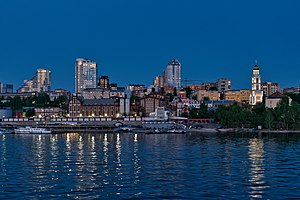 View of Samara in 2018 | |
 Flag .png.webp) Coat of arms | |
Location of Samara 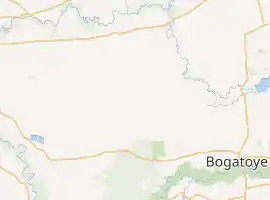
| |
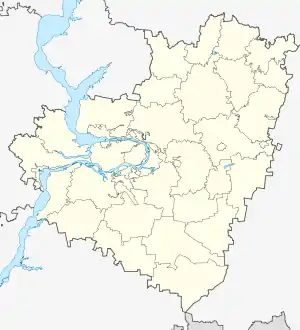 Samara Location of Samara .svg.png.webp) Samara Samara (European Russia)  Samara Samara (Europe) | |
| Coordinates: 53°12′10″N 50°08′27″E | |
| Country | Russia |
| Federal subject | Samara Oblast[2] |
| Founded | 1586[3] |
| City status since | 1688[4] |
| Government | |
| • Body | Samara City Council[5] |
| • Mayor[6] | Elena Lapushkina[6] |
| Area | |
| • Total | 541.382 km2 (209.029 sq mi) |
| Elevation | 100 m (300 ft) |
| Population | |
| • Total | 1,164,685 |
| • Estimate (2018)[9] | 1,163,399 (−0.1%) |
| • Rank | 6th in 2010 |
| • Density | 2,200/km2 (5,600/sq mi) |
| • Subordinated to | city of oblast significance of Samara[2] |
| • Capital of | Samara Oblast[2], Volzhsky District[1] |
| • Urban okrug | Samara Urban Okrug[10] |
| • Capital of | Samara Urban Okrug[10], Volzhsky Municipal District[11] |
| Time zone | UTC+4 (MSK+1 |
| Postal code(s)[13] | 443XXX |
| Dialing code(s) | +7 846[14] |
| OKTMO ID | 36701000001 |
Formerly a closed city, Samara is now a large and important social, political, economic, industrial, and cultural centre in Russia and hosted the European Union—Russia Summit in May 2007. It has a continental climate characterised by hot summers and cold winters. The life of Samara's citizens has always been intrinsically linked to the Volga River, which has not only served as the main commercial thoroughfare of Russia throughout several centuries, but also has great visual appeal. Samara's riverfront is considered one of the favourite recreation places both for local citizens and tourists. After the Soviet novelist Vasily Aksyonov visited Samara, he remarked: "I am not sure where in the West one can find such a long and beautiful embankment."[16]
Etymology
Samara is named after the Samara River, which probably means "summer water" (signifying that it froze in winter) in the Indo-Iranian language which was spoken here 2000 years ago.[17] The Samara city gives its name to the Samara culture, a neolithic culture of the 5th millennium BC, and the Kurgan hypothesis associates the region with the original homeland (urheimat) of the Proto-Indo-European language.[18]
History
Early history
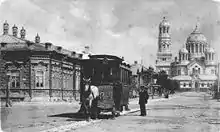
Samara, together with its northern neighbour Kazan, is at the centre of the Idel-Ural historical region. Ahmad ibn Fadlan visited the area that is now Samara around 921 while on his journey to the Volga Bulgars who then controlled the region from their capital Bolghar.[19]
Legend has it that Alexius, Metropolitan of Moscow, later Patron Saint of Samara, visited the site of the city in 1357 and predicted that a great town would be erected there, and that the town would never be ravaged. The Volga port of Samara appears on Italian maps of the 14th century. Before 1586, the Samara Bend was a pirate nest. Lookouts would spot an oncoming boat and quickly cross to the other side of the peninsula whenever the pirates organized an attack. Officially, Samara started with a fortress built in 1586 at the confluence of the Volga and Samara Rivers.[3] This fortress was a frontier post protecting the then easternmost boundaries of Russia from forays of nomads. A local customs office was established in 1600.
As more and more ships pulled into Samara's port, the town turned into a centre for diplomatic and economic links between Russia and the East. Samara also opened its gates to peasant war rebels headed by Stepan Razin and Yemelyan Pugachyov, welcoming them with traditional bread and salt. The town was visited by Peter the Great and later Tsars.
In 1780, Samara was turned into an uyezd town of Simbirsk Governorate overseen by the local Governor-General, and Uyezd and Zemstvo Courts of Justice and a Board of Treasury were established. On January 1, 1851, Samara became the centre of Samara Governorate with an estimated population of 20,000. This gave a stimulus to the development of the economic, political and cultural life of the community. Samara was outside of the Pale of Settlement and as such did not have any significant Jewish population until the late 19th century.[20] In 1877, during the Russian-Turkish War, a mission from the Samara city government Duma led by Pyotr V. Alabin, as a symbol of spiritual solidarity, brought a banner tailored in Samara pierced with bullets and saturated with the blood of both Russians and Bulgarians, to Bulgaria, which has become a symbol of Russian-Bulgarian friendship.
Soviet period
In 1935, Samara was renamed Kuybyshev in honour of the Bolshevik leader Valerian Kuybyshev.
During World War II, Kuybyshev was chosen to be the alternative capital of the Soviet Union should Moscow fall to the invading Germans, until the summer of 1943, when everything was moved back to Moscow. In October 1941, the Communist Party and governmental organisations, diplomatic missions of foreign countries, leading cultural establishments and their staff were evacuated to the city.[21] A dugout for Joseph Stalin known as "Stalin's Bunker" was constructed but never used. To mark its role as wartime national capital a special Revolution Day parade was held at the city's Kuybyshev Square on November 7, 1941, and since 2011 has been remembered in an annual military parade organised by the city government.
As a leading industrial centre, Kuybyshev played a major role in arming the country. From the very first months of World War II the city supplied the front with aircraft, firearms, and ammunition. Health centres and most of the city's hospital facilities were turned into base hospitals. Polish and Czechoslovakian military units were formed on the territory of the Volga Military District. Samara's citizens also fought at the front, many of them volunteers.
After the war the defence industry developed rapidly in Kuybyshev; existing facilities changed their profile and new factories were built, leading to Kuybyshev becoming a closed city. In 1960, Kuybyshev became the missile shield centre for the country. The launch vehicle Vostok, which delivered the first manned spaceship to orbit, was built at the Samara Progress Plant. Yuri Gagarin, the first man to travel in space on April 12, 1961, took a rest in Kuybyshev after returning to Earth. While there, he spoke to an improvised meeting of Progress workers. Kuybyshev enterprises played a leading role in the development of Soviet domestic aviation and the implementation of the Soviet space program. There is also an unusual monument situated in Samara commemorating an Ilyushin Il-2 ground-attack aircraft assembled by Kuybyshev workers in late 1942. This particular plane was shot down in 1943 over Karelia, but the heavily wounded pilot, K. Kotlyarovsky, managed to crash-land the plane near Lake Oriyarvi. The aircraft was returned to Kuybyshev in 1975, and was placed on display at the intersection of two major roads as a symbol of the deeds of home front servicemen and air-force pilots during the Great Patriotic War.
Post-Soviet period


In January 1991, the historical name of Samara was given back to the city. Samara is one of the major industrial cities of Russia and has a multiethnic population.[22]
Geography
Climate
Samara experiences a humid continental climate (Köppen climate classification Dfb borders of Dfa). Samara's humidity levels are higher in the summer than many Russian cities thanks to the precipitation levels and the close proximity to the Volga. The humidity levels usually range from 29% to 98% humidity over the period of a year. There was a record high of +40.4 °C (104.7 °F) during a severe heat wave.
| Climate data for Samara | |||||||||||||
|---|---|---|---|---|---|---|---|---|---|---|---|---|---|
| Month | Jan | Feb | Mar | Apr | May | Jun | Jul | Aug | Sep | Oct | Nov | Dec | Year |
| Record high °C (°F) | 5.2 (41.4) |
6.8 (44.2) |
16.5 (61.7) |
31.1 (88.0) |
33.7 (92.7) |
38.4 (101.1) |
40.4 (104.7) |
39.9 (103.8) |
33.8 (92.8) |
26.0 (78.8) |
14.7 (58.5) |
7.3 (45.1) |
40.4 (104.7) |
| Average high °C (°F) | −6.8 (19.8) |
−6.1 (21.0) |
0.4 (32.7) |
12.0 (53.6) |
20.7 (69.3) |
25.3 (77.5) |
26.9 (80.4) |
24.9 (76.8) |
18.5 (65.3) |
9.8 (49.6) |
0.1 (32.2) |
−5.4 (22.3) |
10.0 (50.0) |
| Daily mean °C (°F) | −9.9 (14.2) |
−9.6 (14.7) |
−3.4 (25.9) |
7.0 (44.6) |
14.9 (58.8) |
19.7 (67.5) |
21.5 (70.7) |
19.4 (66.9) |
13.4 (56.1) |
6.0 (42.8) |
−2.4 (27.7) |
−8.2 (17.2) |
5.7 (42.3) |
| Average low °C (°F) | −12.8 (9.0) |
−12.8 (9.0) |
−6.7 (19.9) |
2.9 (37.2) |
9.8 (49.6) |
14.9 (58.8) |
16.7 (62.1) |
14.7 (58.5) |
9.3 (48.7) |
3.1 (37.6) |
−4.5 (23.9) |
−10.8 (12.6) |
2.0 (35.6) |
| Record low °C (°F) | −43.0 (−45.4) |
−36.9 (−34.4) |
−31.4 (−24.5) |
−20.9 (−5.6) |
−4.9 (23.2) |
−0.4 (31.3) |
6.3 (43.3) |
2.3 (36.1) |
−3.4 (25.9) |
−15.7 (3.7) |
−28.1 (−18.6) |
−41.3 (−42.3) |
−43.0 (−45.4) |
| Average precipitation mm (inches) | 53 (2.1) |
42 (1.7) |
34 (1.3) |
39 (1.5) |
36 (1.4) |
56 (2.2) |
57 (2.2) |
46 (1.8) |
44 (1.7) |
53 (2.1) |
52 (2.0) |
51 (2.0) |
563 (22.2) |
| Average rainy days | 4 | 3 | 5 | 11 | 14 | 15 | 14 | 12 | 14 | 14 | 10 | 6 | 122 |
| Average snowy days | 24 | 20 | 14 | 4 | 1 | 0.1 | 0 | 0 | 0.3 | 4 | 15 | 22 | 104 |
| Average relative humidity (%) | 83 | 80 | 79 | 67 | 58 | 64 | 67 | 69 | 73 | 76 | 83 | 83 | 74 |
| Mean monthly sunshine hours | 64 | 102 | 149 | 214 | 305 | 303 | 310 | 275 | 190 | 108 | 47 | 46 | 2,113 |
| Source 1: Pogoda.ru.net[23] | |||||||||||||
| Source 2: NOAA (sun, 1961–1990)[24] | |||||||||||||
Governance
Administrative and municipal status
Samara is the administrative center of the oblast[2] and, within the framework of administrative divisions, it also serves as the administrative center of Volzhsky District,[1] even though it is not a part of it.[25] As an administrative division, it is, together with two rural localities, incorporated separately as the city of oblast significance of Samara—an administrative unit with the status equal to that of the districts.[2] As a municipal division, the city of oblast significance of Samara is incorporated as Samara Urban Okrug.[10] In April 2015, Samara's nine city districts were granted municipal status.[10]
Demographics
Religious freedom

Samara is a multi-confessional city with various religious groups, including an Orthodox Christian majority and minorities of Armenian Apostolic Christians, Catholics, Protestants, Muslims, and Jews.
However, since 2009, a Russian "anti-extremism" law has led to an increase in repression of religious minorities. Local authorities and courts in Samara have targeted Jehovah's Witnesses by liquidating the group's legal entity ("Local Religious Organization" or "LRO") and designating it as an "extremist" organization.[26] In November 2016, "the Supreme Court of the Russian Federation upheld the decision of the Samara Regional Court to recognize the Samara branch of Jehovah's Witnesses as an extremist organization and to ban its activities."[27]
Economy
Samara is a leading industrial center in the Volga region and is among the top ten Russian cities in terms of national income and industrial production volume. Samara is known for the production of aerospace launch vehicles, satellites and various space services (Progress State Research and Production Rocket Space Center), engines (Kuznetsov Design Bureau) and cables (Volgacable, Samara Cable Company), aircraft (Aviakor) and rolled aluminum, block-module power stations; refining, chemical and cryogenic products; gas-pumping units; bearings of different sizes, drilling bits; automated electrical equipment; airfield equipment (Start plant); truck-mounted cranes; construction materials; chocolates made by the Russia Chocolate Factory; Rodnik vodka; Vektor vodka; Zhiguli beer; food processing and light industrial products.[22]
Culture
Samara has an opera and ballet theater, a philharmonic orchestra hall, and five drama theaters. There is a museum of natural history and local history studies, a city art museum, and a number of movie theaters. As a dedication to the city's contribution to the development of aerospace industry there is a museum Cosmic Samara and an exhibition of aerospace history in Samara State Aerospace University. In the 2000s there has also occurred a large number of art galleries, dedicated to contemporary art.
There is a zoo and a circus in the city.
Samara Regional Museum of Local History named after Pyotr Vladimirovich Alabin is one of the oldest museums of the Volga region, founded on November 13, 1886. At present museum offers 2,500 square meters of exposition and exhibition areas, a 270-seat cinema/lecture hall, and a library with a reading hall. Museum's funds contain around 230,000 items, including abundant archaeological and scientific collections (paleontological, mineralogical, zoological, botanical), and impressive folklore and ethnographical collections. Visitors are offered a wide choice of interesting expositions: paleoecological – "Natural communities of Samara region", archaeological – "Priceless heritage of the times gone by", ethnographic – "Circle of life, reflected in traditions and rituals of the Volga region indigenous peoples", historical – "The Crossroads of Samara history", and other exhibition projects.
The Alabin Museum has three branches:
House-Museum of Vladimir Lenin in Samara is an object of cultural heritage of federal significance. Museum is located on the site of a former city merchant's mansion, dating to the last quarter of the 19th century. The Ulyanov family rented a second floor apartment of the house of Samara merchant Ilya Rytikov from May 1890 to August 1893. During this time Vladimir Ulyanov graduated from St. Petersburg University law school as a non-resident student, and started employment at Samara Regional Court. House-Museum of Vladimir Lenin in Samara opened on January 3, 1940. At present the museum's second floor houses a permanent memorial/household exhibition "Ulyanov family’s apartment in Samara, 1890–1893", recreating the living conditions and household atmosphere of Ulyanov family. The ground floor contains a specialised display area, including a fragment of historical/artistic reconstruction of Ilya Rytikov's merchant shop.
Exposition of Russia's first Museum of Art Nouveau is dedicated to art and culture of late 19th – early 20th centuries. Museum of Art Nouveau opened at the end of 2012 and in just a few years became a local tourist brand. Mansion of Alexandra Kurlina, a merchant's wife and philanthropist, where the museum is located, is considered to be an architectural gem of Samara's Art Nouveau. Original façade and interior survive to this day, representing the works of outstanding European and Russian art nouveau masters. The museum is an exhibition space, which hosts major Russian museums’ projects (The Pushkin Museum, Abramtsevo Museum-Reserve, Moscow Multimedia Art Museum, etc.), and organises exhibitions of its own collections. Museum of Art Nouveau is one of Samara's most popular social and cultural entities. Weekly events take place here, giving visitors a taste of late 19th – early 20th centuries’ culture, as well as current cultural trends. Every year the museum hosts the "Night at the Museum" and "Night of the Arts" events, attended by more than a thousand visitors.
House-Museum of Mikhail Frunze in Samara opened on February 23, 1934. The building was constructed in 1891 and is classed as a monument of residential architecture. On February 23, 2004, on the eve of the 70th anniversary of the museum, a new, 3rd exposition was opened, in which new materials, previously classified as top secret, were exhibited. The exposition tells visitors about lesser known chapters of the 1918-1920 Civil War, the confrontation on the Eastern Front between the armies of Mikhail Frunze and Alexander Kolchak, about "The Reds", "The Whites" and "The Greens", about anti-Soviet uprising behind the lines of the Eastern Front – "Chapan war" ("chapan" means rustic sheepskin coat), the defection in the Red and White armies, and many other chapters of the Russian history. Website: http://alabin.ru
Public events
International festivals, scientific congresses and other social events are held on the territory of Samara. Among them are the most famous:
- Grushinsky festival (Russian: Грушинский фестиваль) — is an annual Russian bard song festival that was established in 1968. It takes place near the city of Samara, on the Mastryukovo lakes. The festival takes its name from Valeri Grushin, a singer-songwriter who died during a backcountry camping trip trying to save his drowning friends.
- Rock over Volga (Russian: Рок над Волгой) — international rock festival, held annually from 2009 to 2013 and timed to the Russia Day in Samara. The line-up included bands such as the Ken Hensley, Aquarium, Skunk Anansie and Rammstein.
- Metafest (Russian: Метафест) — the annual multi-format music festival in the open air, held on the territory of Mastryukovo lakes since 2007. The line-up included bands such as the Ivan Smirnov, Olga Arefieva, Z-Star and Theodor Bastard.
Architecture
Architecture of Samara dates back to 15th and 16th centuries, the city had numerous wooden buildings with elaborate decor and more than 2000 cultural heritage objects. However, after the 1990s many unique ensembles were destroyed by a "concrete tsunami" of modern office and apartment blocks.[28]
Sports

Several sports clubs are active in the city:
| Club | Sport | Founded | Current League | League Tier | Stadium |
|---|---|---|---|---|---|
| Krylia Sovetov | Football | 1942 | Russian Premier League | 1st | Samara Arena |
| CSK VVS Samara | Ice Hockey | 1950 | VHL | 2nd | Kristall Ice Palace |
| Samara | Basketball | 1976 | Russian Basketball Super League 1 | 2nd | MTL Arena |
| Nova | Volleyball | 1993 | Russian Volleyball Super League | 1st | MTL Arena |
| Krylia Sovetov | Beach Soccer | 2010 | Russian Beach Soccer Championships | 1st | Volga Stadium |
| Dinamo-Samara | Futsal | 2018 | Russian Futsal Super League | 1st | MTL Arena |
Samara is also a popular venue for National and International Ice speedway, and the City won the Russian Ice Speedway Premier League in 2012/13 season,[29] meaning they will now compete in the Super League in the 2013/14 season. Samara is one of eleven cities hosting the 2018 FIFA World Cup with 6 matches (4 Group Stage matches, 1 Round of 16 match, 1 Quarter-Final) which will take place in the newly built Cosmos Arena stadium. The stadium's seating capacity is 45,000.
During the World Cup, the city hosted the FIFA Fan Fest on the Kuibysheva Square. Up to 20,000 fans were be able to participate in the event at a time.
Three new training fields have been built in the city for the FIFA World Cup. Two major roads have been repaired before the championship: the airport road and Moskovskoye Highway.
Infrastructure
Transportation
Samara is a major transport hub.
Highways
Samara is located on the M5 highway, a major road between Moscow and the Ural region.
Rail
There are rail links to Moscow and other major Russian cities. The new, unusual-looking railway station building was completed in 2001.[30]
River transport
Samara is a major river port, due to its location at the confluence of the Volga and Samara rivers.
Air
The Kurumoch International Airport handles flights throughout Russia and Central Asia and to Frankfurt, Prague, Helsinki and Dubai. A Soviet Air Force base once existed east of the city at Bobrovka air base.
Public transport
Public transportation includes the Samara Metro, trams, municipal and private bus lines, and trolleybuses. Local trains serve the suburbs.
Tram
Samara Tram is an extensive light rail system covering most of Samara. First opened in 1915 it currently has 25 lines extending 168.2 kilometres (104.5 mi) served by 423 tram cars.[31] Most of all Samara trams are Tatra T3SU, modified Tatra T3E and 1 unique Tatra T3RF.
Metro
Samara Metro is a single-line underground rapid transit system. Opened in 1987, its only line has been expanded through 2015 and currently has 10 stations.
Gallery
.jpg.webp) Golaz-AKA-6226 bus
Golaz-AKA-6226 bus Scania OmniLink bus
Scania OmniLink bus.jpg.webp) ZiU-682 trolleybus
ZiU-682 trolleybus.jpg.webp) AKSM-321 low-floor trolleybus
AKSM-321 low-floor trolleybus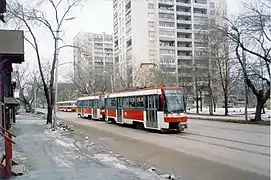 Tatra T3 tram
Tatra T3 tram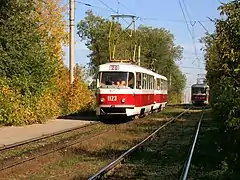 Tatra T3 trams
Tatra T3 trams_(7056155089).jpg.webp)
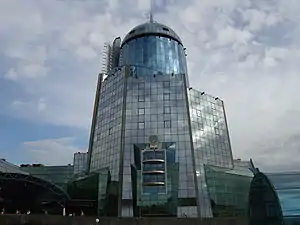
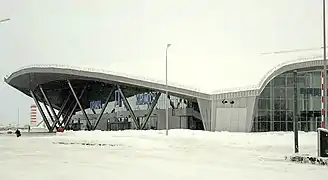
Education
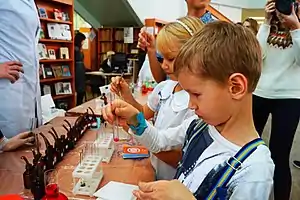
Samara has 188 schools of general education, lyceums, high schools, and the college of continuous education (from primary up to higher education). Samara is a major educational and scientific centre of the Volga area. Twelve public and 13 commercial institutions of higher education as well as 26 colleges.
Samara is the home of Samara State Aerospace University (SSAU), one of Russia's leading engineering and technical institutions. SSAU faculty and graduates have played a significant role in Russia's space program since its conception. Samara is also the hometown of Samara State University, a very respected higher-education institution in European Russia with competitive programs in Law, Sociology, and English Philology. Scientific research is also carried out in Samara. The Samara Research Center of the Russian Academy of Sciences incorporates the Samara branch of the Physical Institute, Theoretical Engineering Institute and Image Processing Systems Institute. Major research institutions operate in the city.[22] Samara State Technical University (SamGTU) was founded in 1914. There are 11 faculties with over 20,000 students (2009) and 1,800 faculty members. On campus, there are four dormitory and ten study buildings. Samara State Academy of Social Sciences and Humanities was founded in 1911 as Samara Teachers Institute. Currently, the academy offers 42 various specialisations in its 12 faculties.[32]
Notable people
- Sergei Alexander Schelkunoff, a mathematician and electromagnetism theorist known for his contributions in antenna theory
- Alexey Tolstoy, Twentieth-century Russian Soviet writer
- Dmitry Shostakovich, composer and pianist, lived in Samara during World War II and finished his Symphony No. 7 while residing in Samara
- Boris Kuftin, archaeologist and ethnographer
- Pavel Romanov, Russian sociologist and ethnographer
- Anastasia Pavlyuchenkova, professional tennis player and multiple junior Grand Slam champion
- Semyon Varlamov, NHL goaltender for the Colorado Avalanche
- Maria Kuncewiczowa, Polish writer and novelist
International relations
References
Notes
- Государственный комитет Российской Федерации по статистике. Комитет Российской Федерации по стандартизации, метрологии и сертификации. №ОК 019-95 1 января 1997 г. «Общероссийский классификатор объектов административно-территориального деления. Код 36 214», в ред. изменения №278/2015 от 1 января 2016 г.. (State Statistics Committee of the Russian Federation. Committee of the Russian Federation on Standardization, Metrology, and Certification. #OK 019-95 January 1, 1997 Russian Classification of Objects of Administrative Division (OKATO). Code 36 214, as amended by the Amendment #278/2015 of January 1, 2016. ).
- Charter of Samara Oblast
- Molly O'Neal (August 20, 2015). Democracy, Civic Culture and Small Business in Russia's Regions: Social Processes in Comparative Historical Perspective. Routledge. p. 79. ISBN 978-1-317-43509-9.
- Russia. Ministerstvo puteĭ soobshchenīi︠a︡; John Marshall (1900). Guide to the Great Siberian Railway. Ministry of Ways of Communication. pp. 86–.
- "Дума городского округа Самара | Официальный сайт | Самарская городская Дума". www.gordumasamara.ru. Samara City Council. Retrieved August 10, 2016.
- Глава Самары Елена Лапушкина проголосовала на выборах Президента России. samadm.ru (in Russian). City of Samara. Retrieved April 2, 2018.
- Пояснительная записка к Генеральному плану г.о. Самара. Приложение 1. Основные технико-экономические показатели с.21
- Russian Federal State Statistics Service (2011). "Всероссийская перепись населения 2010 года. Том 1" [2010 All-Russian Population Census, vol. 1]. Всероссийская перепись населения 2010 года [2010 All-Russia Population Census] (in Russian). Federal State Statistics Service.
- "26. Численность постоянного населения Российской Федерации по муниципальным образованиям на 1 января 2018 года". Federal State Statistics Service. Retrieved January 23, 2019.
- Law #23-GD
- Law #189-GD
- "Об исчислении времени". Официальный интернет-портал правовой информации (in Russian). June 3, 2011. Retrieved January 19, 2019.
- Почта России. Информационно-вычислительный центр ОАСУ РПО. (Russian Post). Поиск объектов почтовой связи (Postal Objects Search) (in Russian)
- "Samara city, Russia travel guide". russiatrek.org. Retrieved August 10, 2016.
- "RUSSIA: Privolžskij Federal'nyj Okrug: Volga Federal District". City Population.de. August 4, 2020. Retrieved October 1, 2020.
- Thom Wheeler (August 13, 2015). Way a River Went: Following the Volga Through the Heart of Russia. Summersdale. p. 120. ISBN 978-1-78372-629-5.
- "Топография крепости Самара 1586-1706 гг., этимология и предшествующие упоминания топонима в письменных источниках (Topography of the Samara fortress, etymology and preceding mentioning of the toponim in the written sources)". www.academia.edu. Retrieved December 11, 2015.
- Balter, Michael (13 February 2015). "Mysterious Indo-European homeland may have been in the steppes of Ukraine and Russia". Science. doi:10.1126/science.aaa7858. Retrieved 17 February 2015.
- DK (September 20, 2010). Explorers: Tales of Endurance and Exploration. DK Publishing. p. 33. ISBN 978-0-7566-7511-0.
- Vladimirsky, Irena. "The Jewish Community of Samara, Russia". The Museum of the Jewish People at Beit Hatfutsot. Retrieved June 27, 2018.
- Andrew Nagorski: The Greatest Battle, 2007, pp. 165–166
- Home page | Home page | Samara City Administration Archived December 6, 2008, at the Wayback Machine
- "Pogoda.ru.net" (in Russian). Weather and Climate (Погода и климат). Retrieved December 10, 2015.
- "Kujbysev/Bezencuk (Samara) Climate Normals 1961–1990". National Oceanic and Atmospheric Administration. Retrieved December 10, 2015.
- Государственный комитет Российской Федерации по статистике. Комитет Российской Федерации по стандартизации, метрологии и сертификации. №ОК 019-95 1 января 1997 г. «Общероссийский классификатор объектов административно-территориального деления. Код 36 401», в ред. изменения №278/2015 от 1 января 2016 г.. (State Statistics Committee of the Russian Federation. Committee of the Russian Federation on Standardization, Metrology, and Certification. #OK 019-95 January 1, 1997 Russian Classification of Objects of Administrative Division (OKATO). Code 36 401, as amended by the Amendment #278/2015 of January 1, 2016. ).
- RELIGIOUS FREEDOM CONCERNS IN RUSSIA: STATEMENT BY THE ADMINISTRATIVE CENTER OF JEHOVAH'S WITNESSES IN RUSSIA, for the OSCE Human Dimension Implementation Meeting, Warsaw, 22 September to 3 October 2014.
- Misuse of Anti-Extremism in November 2016, SOVA Center (December 12, 2016).
- "Concrete tsunami is wiping out Russian heritage, say architects". The Guardian. December 7, 2009. Retrieved November 24, 2020.
- http://www.icespeedway.co.uk/russia.html
- Russian Railways: The History of Railways, 21st Century
- "Транспортный оператор Самары – Транспорт нашего города". tosamara.ru. Retrieved July 5, 2018.
- "Archived copy". Archived from the original on November 14, 2011. Retrieved August 31, 2011.CS1 maint: archived copy as title (link)
- "Международные связи". samadm.ru (in Russian). Samara. Retrieved February 3, 2020.
Sources
- Самарская Губернская Дума. №179-ГД 18 декабря 2006 г. «Устав Самарской области», в ред. Закона №6-ГД от 11 января 2016 г. «О внесении изменений в Устав Самарской области». Вступил в силу 1 января 2007 г. Опубликован: "Волжская коммуна", №237 (25790), 20 декабря 2006 г. (Samara Governorate Duma. #179-GD December 18, 2006 Charter of Samara Oblast, as amended by the Law #6-GD of January 11, 2016 On Amending the Charter of Samara Oblast. Effective as of January 1, 2007.).
- Самарская Губернская Дума. Закон №189-ГД от 28 декабря 2004 г. «О наделении статусом городского округа и муниципального района муниципальных образований в Самарской области», в ред. Закона №23-ГД от 30 марта 2015 г. «Об осуществлении местного самоуправления на территории городского округа Самара Самарской области». Вступил в силу по истечении десяти дней со дня официального опубликования. Опубликован: "Волжская коммуна", №247, 31 декабря 2004 г. (Samara Governorate Duma. Law #189-GD of December 28, 2004 On Granting the Status of Urban Okrug and Municipal District to the Municipal Formations in Samara Oblast, as amended by the Law #23-GD of March 30, 2015 On the Implementation of Local Self-Government on the Territory of Samara Urban Okrug of Samara Oblast. Effective as of after ten days from the day of the official publication.).
- Самарская Губернская Дума. Закон №23-ГД от 30 марта 2015 г. «Об осуществлении местного самоуправления на территории городского округа Самара Самарской области». Вступил в силу по истечении десяти дней со дня официального опубликования. Опубликован: Официальный сайт Правительства Самарской области, 30 марта 2015 г. (Samara Governorate Duma. Law #23-GD of March 30, 2015 On the Implementation of Local Self-Government on the Territory of Samara Urban Okrug of Samara Oblast. Effective as of after ten days from the day of the official publication.).
External links
![]() Samara travel guide from Wikivoyage
Samara travel guide from Wikivoyage
- Official website (in Russian)
- Samara city on Instagram
- Samara at Curlie
